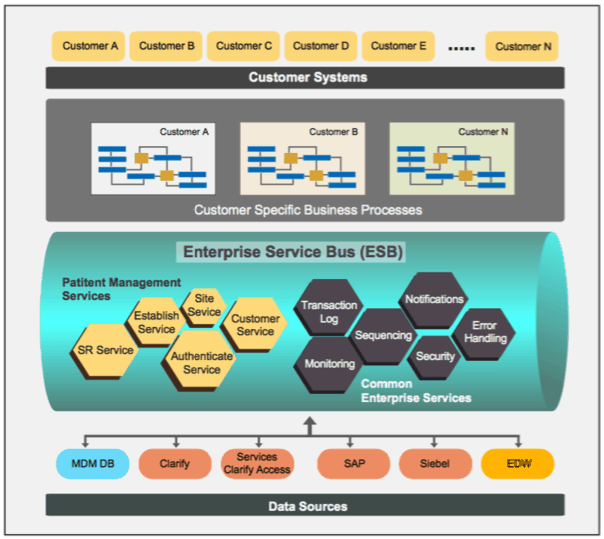MANUFACTURING MANAGED SERVICES
ORGANIZATION
The client is a subsidiary of a larger technology corporation with 1,500 employees (FY06) in more than 41 countries. Their key focus is on research and development of networking products and communication technologies with reliance on other business professionals to provide services not related to product engineering and development.
CHALLENGE
The client was faced with rising costs for servicing; therefore, they sought to outsource its help desk functions, inventory management, and service dispatching to third parties. The plan was to meet customer needs while shifting the focus back to their core competencies. The strategy involved working with multiple partners with core competencies including, but not limited to business services (customer service), shipping and handling, and warehouse management.
The major challenge was implementing an automated integrated process involving service desk, RMA, parts manufacturing, and the customer systems. This process needed to seamlessly integrate customers SLA systems, partners CRM and supply chain processes and systems, service desk scheduling systems, and parts suppliers ordering systems. Additionally, the solution needed to support the RMA process globally with varied shipping requirements and multiple shippers specialized in local market segments.
SOLUTION
The client called on XTIVIA to form a business partnership to build a sustainable new business model. The project objectives were lofty by any standard and implementation had to occur within 90 days.
XTIVIA used a combination of Service Oriented Architecture (SOA) for Enterprise Application Integration and RosettaNet Process Integration for Business to Business (B2B) process integration and data warehousing. Additionally, XTIVIA also used Business Intelligence for SLA reporting management technologies to achieve the client goals.
This composite solution, as well as the infrastructure built for sustainability, scalability, and reliability was implemented in the 90-day window to achieve the following objectives:
- Leverage the information contained in legacy systems to condense development time.
- Allow the non-contract (retail) customers to register site, product, and contact information through a web interface to lower costs.
- Merge information from SAP for contract (corporate) customers to an overall customer database.
- Allow all customers to enter service requests through a web interface.
- Establish a Real-time Inventory Management to establish a parts hub and field level service sites.
- Meet the level of service under existing service level agreements (SLAs).
- Create a viable model for global operations in Europe and Asia/Pacific.
- Continue uninterrupted business operations throughout the conversion and implementation process.
USING SOA AND B2B
Considering the vast amount of information on existing customers, the need to simplify the handling of warranty information, entry of service requests, and the outsourcing requirement to third parties, SOA provided the key to making the other requirements of the solution work. Loosely coupled systems supplied the flexibility in the B2B portion of the solution that needed to allow the data to flow to the vendor handling parts and dispatch and the vendor managing the service request functions. XTIVIA designed and developed all the services for managing the customers, parts, service requests, RMA, and shipping information. These services enabled seamless integration between the legacy systems, which enabled a high degree of transparency and location independence.
MASTER DATA INITIALIZATION AND SYNCHRONIZATION
XTIVIA needed to build a bi-directional integration for synchronizing customer and parts information between the
service desk partner and the customer. XTIVIA used the same integration bridge to initialize the master data for
the service desk partner thus achieving the data initialization goal as well as robust validation, load, and
performance testing of the integration.
ENTERPRISE SERVICE BUS
To meet the aggressive timelines, XTIVIA leveraged its common service suite (XTIVIA Integration Services) as a
foundation for the Enterprise Service Bus (ESB). The ESB also hosted services that XTIVIA built for managing customers, parts, RMA, Service Requests, etc. The Plug-n-Play architecture of the ESB enabled the Service desk partner to integrate additional CRM customers in less than two weeks with little difficulty.

RESULTS
XTIVIA helped its customer focus on the products and services making a direct bottom-line impact by using business processing and application integration. The benefits for XTIVIA’s client included:
- Quick implementation 90 days start to finish.
- Business continuity during conversion to the new high quality, reliable system.
- Creation of a viable model for global operations in the Middle East, Europe, Africa and Asia/Pacific.
- Lowering the cost to provide help desk functions ensuring service priorities were managed according to existing SLAs.
- Gaining business information to assist in future marketing efforts and real-time inventory management to ensure availability of the right parts at the right locations.
- Scalable infrastructure that enabled the customer to reduce the on-boarding time of new customers from two months to two weeks.
KEY COMPONENTS
TECHNOLOGIES USED
TIBCO
SOA
BPM
Mobile Apps
JMS
Java
Let's Talk Today!
XTIVIA CORPORATE OFFICE
304 South 8th Street, Suite 201
Colorado Springs, CO 80905 USA
Additional offices in New York, New Jersey,
Missouri, Texas, Virginia, and Hyderabad, India.
USA toll free: 888-685-3101, ext. 2
International: +1 719-685-3100, ext. 2
Fax: +1 719-685-3400
XTIVIA needs the contact information you provide to us to contact you about our products and services. You may unsubscribe from these communications at anytime, read our Privacy Policy here.
